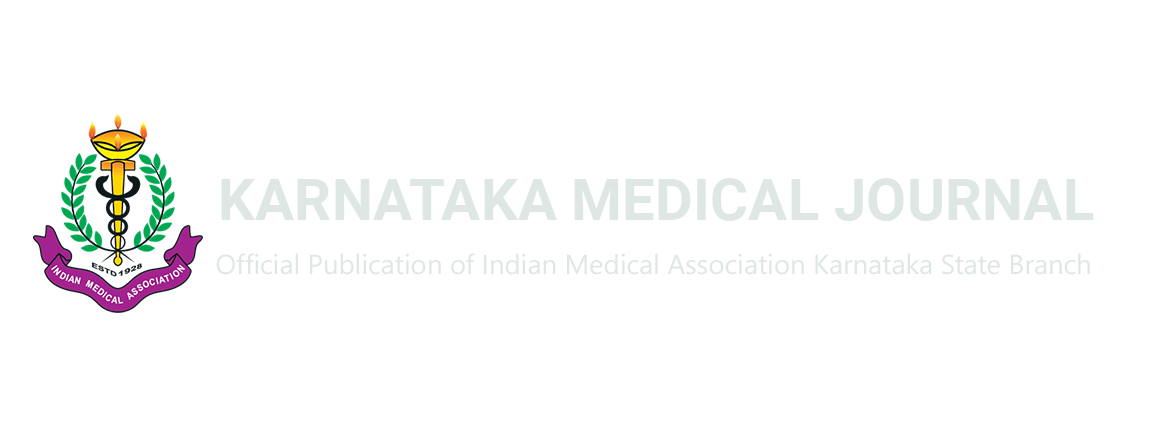Translate this page into:
Abdominal TB still a challenge to manage?
*Corresponding author: S. Y. Mulkipatil, Department of Surgery, Karnataka Institute of Medical Sciences, Hubli, Karnataka, India. drsympatil@yahoo.com
-
Received: ,
Accepted: ,
How to cite this article: Mulkipatil SY. Abdominal TB still a challenge to manage? Karnataka Med J. 2024;47:1-2. doi: 10.25259/KMJ_32_2024
Tuberculosis (TB) is a chronic inflammatory disease caused by Mycobacterium, one of the oldest human diseases with its history as old as mankind. TB remains the number one cause of adult deaths by a curable disease and was a major public health threat before 1940.
Robert Koch is a German scientist who discovered the organism on 24th March 1882. It is acid– fast bacilli mainly spread by droplets, 3000 infectious nuclei per cough. It is broadly classified as pulmonary TB, extrapulmonary TB, disseminated TB, miliary TB and abdominal TB.
Abdominal TB is defined as TB infection of the abdomen, including the gastrointestinal tract, peritoneum, omentum, mesentery and its nodes and other solid intra-abdominal organs such as liver, spleen and pancreas. It is one of the most common forms of extrapulmonary TB. TB peritonitis, 4–10% of extrapulmonary TB, occurs in 0.1–3.5% of patients with pulmonary TB. Activation of longstanding latent foci of TB infection of the peritoneum, haematogenous or contagious.
It may present as acute TB peritonitis, closely resembles acute abdomen, straw-coloured fluid, tubercles over peritoneum and omentum will help us to detect it. Whereas chronic TB peritonitis presents in middle age, most of them present pain in the abdomen, fewer, mass or varies in the presentation, which becomes difficult to detect. It varies from stomach, small intestine to large bowel. Mostly in the large bowel due to increased physiological stasis, greater contact time, increased rate of fluid and electrolyte absorption, liquid content in the region, minimal digestive activity etc. The chronic granulomatous lesion in ileocecal area, mass in the right ileac fossa (RIF) may also present symptoms.
Complications include stricture, subacute intestinal obstruction, intestinal obstruction and ulceration.
Diagnostic modalities
Chest X-ray- for Primary lesion, Barium study- ileal stricture with hypermotility, Pulled up caecum, obtuse ileocecal angle. Abdominal TB with human immunodeficiency virus coinfection is almost 50%. X-ray abdomen shows dilated bowel loops with fluid levels, dilatation of the terminal ileum and ascites, Pneumoperitoneum – perforation. Abdominal ultrasonography – Mass, fine septae in ascitic fluid, Club- sandwich appearance etc. The ascitic fluid examination may show Serum ascitic albumin gradient (SAAG) <1.1, protein level >2.5 g/dL, white blood cells count >250–>4000 cells/cu mm, acid–fast bacillus (AFB) in ascitic fluid <3%, AFB culture from ascitic fluid <20% and adenosine deaminase (ADA) assay sensitive and specific marker for TB 95% and 98%, respectively. Role of endoscopic biopsy material- 80% diagnosis. Blind percutaneous peritoneal biopsy and open parietal peritoneal biopsy may yield - 80% accuracy.
Serodiagnosis
Detection of specific antibodies to mycobacterium TB, immunoglobulin G component has high specificity for abdominal TB, and Genetic tests like polymerase chain reaction (PCR)- assay of endoscopically biopsied tissue or ascites, deoxyribonucleic acid (DNA) – PCR can detect 1–2 organisms or 8 fg of mycobacterial DNA.
Laparoscopy
Direct visualisation – Multiple, yellowish-white, miliary nodules over the visceral and parietal peritoneum, erythematous, thickened, and hyperaemic peritoneum, turbid ascites and adhesions.
Treatment
Medical- Main stay of treatment with Short course anti tuberculosis treatment (ATT) chemotherapy - 6 months
First-line drugs
High anti-tubercular activity, low toxicity and are used routinely-Isoniazid (INH), Rifampicin, Pyrazinamide, Ethambutol, Streptomycin.
Second-line drugs include
Thiacetazone, Para amino salicylic acid (PAS), Ethionamide, Cycloserine, Kanamycine, Amikacin, Capreomycin were used depending on drug sensitivity test (DST) to treat multidrug-resistant (MDR) TB.
Newer regimens – Include shorter oral Bedaquiline containing MDR regimen also recommended by National tuberculosis elimination program (NTEP).
Laparoscopic adhesiolysis
Avoids unnecessary laparotomy in a large number of patients, increasingly used for definitive surgical treatment of abdominal TB, management of hepatobiliary TB, obstructive jaundice – ATT + biliary decompression, endoscopic retrograde cholangiopancreatography (ERCP) – stent insertion and surgical decompression.
Overall, the success of the treatment includes a team approach, starting from notification, adherence to the drugs by the patient, patient support and follow-up with regular counselling on the disease and treatment. If all the health-care providers work together, we can achieve the elimination of the TB.





